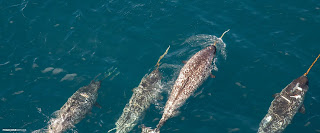Marine Creature of the Month May '19
Marine Creature of the Month
Narwhal
 |
| Photo from Arctic Kingdom |
Kingdom: Animalia
Class: Mammalia
Conservation Status: Near Threatened (NT)
WHERE DO THEY LIVE?
Narwhals live in the arctic waters around Canada, Greenland, and Russia. They are migratory creatures which live in open waters during the winter months and bay areas during the summer months.
WHAT DO THEY LOOK LIKE?
So if a unicorn and a dolphin had a baby, it would probably look a lot like a narwhal. These mottled grey toothed whales have a protruding tusk which resembles a horn. The tusk is actually a tooth which literally grows out of their faces. It is mostly the males which have the tusk but it isn't uncommon for the females to grow them too. In fact, 15% of them do though theirs are smaller of than the males. Overall, narwhals are medium sized whales, averaging between 3.95-5.5m (13-18ft) with an extra 1.5-3.1m (4.9-10.2ft) for the tusk. These tusks are actually hollow and used as a sensory organ and made up of nerve endings. It is believed to be used for communication - about the water conditions and whatnot. Whatever narwhals talk about.
Narwhals do not have a dorsal fin and have jointed vertebrae unlike other whales and dolphins which have fused vertebrae. Their large, bulbous heads are known as melons which is actually also another sensory organ. They are a dark grey colour from birth and get lighter with age; some males even go completely white. All of these factors create the iconic image that is the narwhal.
 |
| Photo from ThoughtCo |
HOW DO THEY LIVE?
These majestic creatures live up to fifty years old. The females reach maturity between five and eight years while the males mature between eleven and thirteen years. They birth one baby at a time after 14 months of gestation. Baby narwhals are born with thin blubber which thickens while nursing on milk rich which fat. The young remain dependant on their mothers for two years.
They have an interesting hunting technique. When hunting in the summer months and feeding on fish like arctic cod, they slap their prey with their tusk to stun it before sucking it into their mouths. Because they migrate, their diet changes over the year. During the winter months, when there is thick ice on the surface they hunt deep below the surface on benthic creatures. Males will dive to great depths up to 1,500m (4,920ft) during this time, up to twenty-five minutes at a time.
They live in groups of five to ten whales, or up to twenty in the winter months. These groups converge in the summer, creating groups of thousands of narwhals . They communicate via clicks, whistles, and knocks.
WHAT THREATENS THEM?
There are a few things which threaten narwhals and not all of them are human related. When migrating, if they do not time it right the sea can freeze over and effectively leave them trapped under the water. Being mammals, and needing to breathe air, this leads to them suffocating. They are hunted by arctic predators like orcas and polar bears. Orcas hunt in formation while polar bears target their breathing holes. Rather than out run orcas, narwhals hide from them because they would never be able to out race them.
There are two threats from humans, however. Inuits hunt narwhals for meat and ivory, and have done for centuries. It is part of their culture. But they are also affected by climate change. They are very sensitive to climate change as it affects their migration and feeding grounds. While their population numbers are stable, they are still affected by the extreme conditions of climate change.
 |
| Photo from the WWF |
FUN FACTS
- Narwhals are the deepest diving marine mammal.
- They are in the same family as belugas, both are white wales known as Monodontidae.
- The "nar" in "narwhal" comes from the Old Norse word meaning corpse. This refers to their grey, mottled colour.
- Some males have been known to develop two tusks. This happens about 1 in 500 times in males.
- It has only ever happened once in females.
- Bonus fun fact: My partner is convinced they are not real! Here's hoping this helps.
Pinterest Board: #MCotM May '19



Comments
Post a Comment